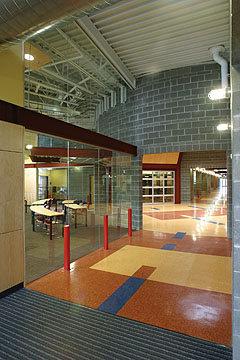|
Subscribe / Renew |
|
|
Contact Us |
|
| ► Subscribe to our Free Weekly Newsletter | |
| home | Welcome, sign in or click here to subscribe. | login |
Construction
| |
 |
September 22, 2005
Communities play larger role in shaping schools
Special to the Journal

Weekes
|

Hendricks
|
More than 59 million teachers, students, parents and support personnel spend part of their day in over 120,000 school buildings throughout the United States.
This year over $30 billion dollars will be spent nationwide on new school construction, repairs and maintenance. Communities are changing their views of schools and the roles school districts should play within their communities. Because of the perceived failure of many of our nation's schools, political leaders are increasingly involved, mandating specific educational goals locally, regionally, and nationally.
Against this backdrop, teaching and learning strategies are being transformed to meet the social, economic and political challenges of the coming decades. The forces from both inside and outside of the American schoolhouse are changing preconceived notions of teaching, learning, space and place. The new American school will be anything but the school we visited 20 or 30 years ago, including not only how learning will be organized, but how school will look, function and feel.
Interestingly, the Pacific Northwest is considered a leader in the research, thinking and implementation of the next generation of learning strategies and schoolhouse design.
Fueled by an in-migration of new families drawn by the quality of life, institutions that are actively involved in educational research and development, businesses with highly paid employees who need specific skills, and education-focused foundations such as the Bill and Melinda Gates Foundation, the Northwest is an incubator of new school design that is garnering national and international attention.

Photo courtesy of Dull Olson Weekes Architects
Canby (Ore.) High School's Applied Technology Center was built in a joint venture with Clackamas Community College and counts Intel among its community business partners.
|
A fairly well-educated populace, as well as relatively stable growth in student populations over the last 20 years, has allowed us to be thoughtful about school planning, rather than simply react to explosive growth by building as fast as possible, as was the case in the 1960s and is still occurring in places like Las Vegas.
What are the factors that are shaping the school of the future?
Focus on learning
For many decades, the focus on school planning has been, to put it bluntly, on housing students. You take the number of bodies and divide by 30 per classroom, and that's how big your school is.
But the possibilities for schools change if you start with a focus on learning. Students are not all the same. They have individual learning styles and naturally develop understandings at different rates. This requires teachers to individualize instruction for students, particularly when the current emphasis on standardized testing expects all students to achieve the same benchmarks at the same time.
The current emphasis on creating smaller schools is an outgrowth of this fundamental understanding. So many of the constraints driving the typical school system have to do with factors only vaguely related to academic learning, such as the efficiency of the school bus system or the timing of sports practice.
In the typical American high school, a teacher must engage with about 150 different students each semester. How can we expect them to learn the names, much less the individual learning styles, of such a large group of adolescents?
The small school reorganizes staff responsibilities so that every adult is teaching and counseling a group of 20 or fewer students. This provides the opportunity for the adults to really get to know the students over time, and to personalize instruction so that every student can be successful.
Additionally, the role of architecture in supporting learning is increasingly better understood, with ongoing research suggesting a direct link between the built environment and student success. For example, a recent study on daylighting of classrooms found "a compelling statistical correlation between the amount of daylighting in elementary school classrooms and the performance of students on standardized math and reading tests."
Organizations such as the Academy of Neuroscience for Architecture are seeking to build upon the insights gained during the "decade of the brain" to deepen our understanding of how our environments shape our experience.
Community engagement
Traditional decision-making processes that shape both educational program and building design are changing.
Typically school districts have made most of the important decisions about program and school design in the absence of substantial community involvement. Their outreach has often consisted only of putting forward their plans and getting a little community feedback, Increasingly schools have realized that if they are to garner their community's support on levies and bond issues, they must reach out and invite authentic community participation in these important decisions, and must truly grapple with tough issues.
Schools in districts that have done so, such as Vancouver and Edmonds, have fostered richer program opportunities as relationships are built between the community and its schools. They have also produced better buildings, as the community demands facilities that are flexible to meet changing program needs, durable to last more than 30 years, sustainable to meet today's growing environmental awareness, and accommodating of community uses.
Nationally, we're beginning to see serious attempts to link the planning and design of schools with the planning of the cities and communities of which they're a part.
Efforts such as the American Architectural Foundation's School Design Institute, which is modeled after the Mayors' Institutes on City Design, are bringing together mayors, school superintendents and other officials and hosting three-day workshops where they meet with national experts on school-design trends and explore how they can more creatively leverage the resources being invested in their cities.
Changes in the process
Traditionally the information required to develop and implement educational programs has been provided solely by educators. Architects then develop designs that respond to this information, and contractors construct the resulting design.
The growing influence of community, foundations and politicians is reshaping this process. The process is becoming more integrated as traditional roles and responsibilities are being redefined.
Innovative and knowledgeable architects and planners who understand future opportunities and directions in educational programs are being utilized by school districts to help renew existing schools or create new school programs and environments.
Their traditional skills in coordinating a diverse group of engineers and construction consultants are now finding applications in the educational system, and they are increasingly assuming a role in the development of educational program design.
Looking at what works
The nature and shape of the schoolhouse has typically evolved from a long tradition and familiarity with previously designed schools. Terms like classroom, cafeteria, gym and library conjure in our collective memories a consistent image.
Increasingly the change in educational program directions is leading designers and users of schools to look for references outside the traditional educational typology.
Analysis of student behaviors and interests outside the classroom are being incorporated into contemporary school designs. New schools draw from the design strategies of effective business, institutional and commercial environments, and this is reshaping the way schools look and feel.
A sustainable system
Two forces are increasing the quality and sustainability of schools being designed today.
Dwindling maintenance and operational budgets are driving districts to look at ways of being increasingly energy- and resource-efficient. School districts and communities are beginning to embrace the idea that the cheapest facility is often not the wisest choice. Common sense is leading communities to view the design and construction of new school buildings as a long-term investment that requires thoughtful consideration of initial and long-term costs.
In addition, communities and politicians are increasingly expecting that public facilities be environmentally friendly. The Washington Sustainable Schools Protocol is a rating system that's tailored green-building criteria to the building of public schools, and was signed into law in April of this year. While it does not mandate green building for schools, and some districts had already been implementing sustainable building practices, now all schools will be expected to review their projects in light of this rating system.
The future of education represents both challenges and opportunities. At the forward edge of the curve, the Northwest commands an interesting and important role in leading the way. The next steps are the most important but communities, educators, architects and contractors are coming together in unique ways to support teaching and learning, and develop appropriate space and place for the next generations of students.
John Weekes is a founding partner at Dull Olson Weekes Architects. Cheri Hendricks is president of Broadview Associates and a member of the National Leadership Group for the AIA Committee on Architecture for Education.
Other Stories:
- Softening the landing for college freshmen
- Small schools best prepared to teach the new '3 R's'
- Schools districts discover the value of sustainability
- How to meet new state rules and provide real value
- Top concern of every school staff: air quality
- New schools teach lessons on technology design
- Why process isn't a dirty word


